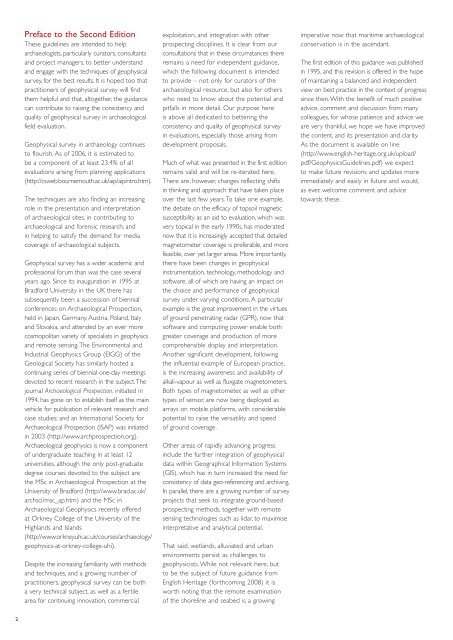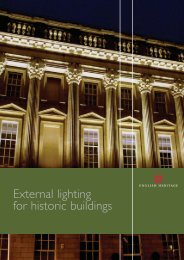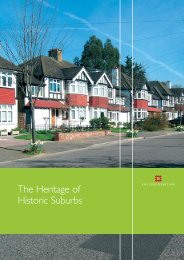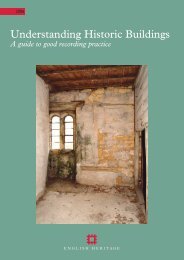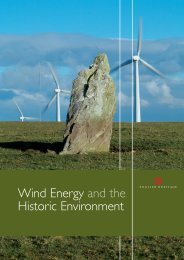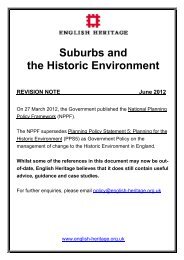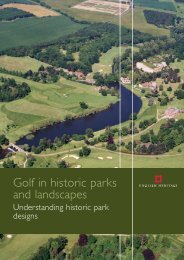Geophysical Survey in Archaeological Field Evaluation - HELM
Geophysical Survey in Archaeological Field Evaluation - HELM
Geophysical Survey in Archaeological Field Evaluation - HELM
You also want an ePaper? Increase the reach of your titles
YUMPU automatically turns print PDFs into web optimized ePapers that Google loves.
2<br />
Preface to the Second Edition<br />
These guidel<strong>in</strong>es are <strong>in</strong>tended to help<br />
archaeologists, particularly curators, consultants<br />
and project managers, to better understand<br />
and engage with the techniques of geophysical<br />
survey, for the best results. It is hoped too that<br />
practitioners of geophysical survey will f<strong>in</strong>d<br />
them helpful and that, altogether, the guidance<br />
can contribute to rais<strong>in</strong>g the consistency and<br />
quality of geophysical survey <strong>in</strong> archaeological<br />
field evaluation.<br />
<strong>Geophysical</strong> survey <strong>in</strong> archaeology cont<strong>in</strong>ues<br />
to flourish. As of 2006, it is estimated to<br />
be a component of at least 23.4% of all<br />
evaluations aris<strong>in</strong>g from plann<strong>in</strong>g applications<br />
(http://csweb.bournemouth.ac.uk/aip/aip<strong>in</strong>tro.htm).<br />
The techniques are also f<strong>in</strong>d<strong>in</strong>g an <strong>in</strong>creas<strong>in</strong>g<br />
role <strong>in</strong> the presentation and <strong>in</strong>terpretation<br />
of archaeological sites, <strong>in</strong> contribut<strong>in</strong>g to<br />
archaeological and forensic research, and<br />
<strong>in</strong> help<strong>in</strong>g to satisfy the demand for media<br />
coverage of archaeological subjects.<br />
<strong>Geophysical</strong> survey has a wider academic and<br />
professional forum than was the case several<br />
years ago. S<strong>in</strong>ce its <strong>in</strong>auguration <strong>in</strong> 1995 at<br />
Bradford University <strong>in</strong> the UK there has<br />
subsequently been a succession of biennial<br />
conferences on <strong>Archaeological</strong> Prospection,<br />
held <strong>in</strong> Japan, Germany, Austria, Poland, Italy<br />
and Slovakia, and attended by an ever more<br />
cosmopolitan variety of specialists <strong>in</strong> geophysics<br />
and remote sens<strong>in</strong>g. The Environmental and<br />
Industrial Geophysics Group (EIGG) of the<br />
Geological Society has similarly hosted a<br />
cont<strong>in</strong>u<strong>in</strong>g series of biennial one-day meet<strong>in</strong>gs<br />
devoted to recent research <strong>in</strong> the subject. The<br />
journal <strong>Archaeological</strong> Prospection, <strong>in</strong>itiated <strong>in</strong><br />
1994, has gone on to establish itself as the ma<strong>in</strong><br />
vehicle for publication of relevant research and<br />
case studies; and an International Society for<br />
<strong>Archaeological</strong> Prospection (ISAP) was <strong>in</strong>itiated<br />
<strong>in</strong> 2003 (http://www.archprospection.org).<br />
<strong>Archaeological</strong> geophysics is now a component<br />
of undergraduate teach<strong>in</strong>g <strong>in</strong> at least 12<br />
universities, although the only post-graduate<br />
degree courses devoted to the subject are<br />
the MSc <strong>in</strong> <strong>Archaeological</strong> Prospection at the<br />
University of Bradford (http://www.brad.ac.uk/<br />
archsci/msc_ap.htm) and the MSc <strong>in</strong><br />
<strong>Archaeological</strong> Geophysics recently offered<br />
at Orkney College of the University of the<br />
Highlands and Islands<br />
(http://www.orkney.uhi.ac.uk/courses/archaeology/<br />
geophysics-at-orkney-college-uhi).<br />
Despite the <strong>in</strong>creas<strong>in</strong>g familiarity with methods<br />
and techniques, and a grow<strong>in</strong>g number of<br />
practitioners, geophysical survey can be both<br />
a very technical subject, as well as a fertile<br />
area for cont<strong>in</strong>u<strong>in</strong>g <strong>in</strong>novation, commercial<br />
exploitation, and <strong>in</strong>tegration with other<br />
prospect<strong>in</strong>g discipl<strong>in</strong>es. It is clear from our<br />
consultations that <strong>in</strong> these circumstances there<br />
rema<strong>in</strong>s a need for <strong>in</strong>dependent guidance,<br />
which the follow<strong>in</strong>g document is <strong>in</strong>tended<br />
to provide – not only for curators of the<br />
archaeological resource, but also for others<br />
who need to know about the potential and<br />
pitfalls <strong>in</strong> more detail. Our purpose here<br />
is above all dedicated to better<strong>in</strong>g the<br />
consistency and quality of geophysical survey<br />
<strong>in</strong> evaluations, especially those aris<strong>in</strong>g from<br />
development proposals.<br />
Much of what was presented <strong>in</strong> the first edition<br />
rema<strong>in</strong>s valid and will be re-iterated here.<br />
There are, however, changes reflect<strong>in</strong>g shifts<br />
<strong>in</strong> th<strong>in</strong>k<strong>in</strong>g and approach that have taken place<br />
over the last few years. To take one example,<br />
the debate on the efficacy of topsoil magnetic<br />
susceptibility as an aid to evaluation, which was<br />
very topical <strong>in</strong> the early 1990s, has moderated<br />
now that it is <strong>in</strong>creas<strong>in</strong>gly accepted that detailed<br />
magnetometer coverage is preferable, and more<br />
feasible, over yet larger areas. More importantly,<br />
there have been changes <strong>in</strong> geophysical<br />
<strong>in</strong>strumentation, technology, methodology and<br />
software, all of which are hav<strong>in</strong>g an impact on<br />
the choice and performance of geophysical<br />
survey under vary<strong>in</strong>g conditions. A particular<br />
example is the great improvement <strong>in</strong> the virtues<br />
of ground penetrat<strong>in</strong>g radar (GPR), now that<br />
software and comput<strong>in</strong>g power enable both<br />
greater coverage and production of more<br />
comprehensible display and <strong>in</strong>terpretation.<br />
Another significant development, follow<strong>in</strong>g<br />
the <strong>in</strong>fluential example of European practice,<br />
is the <strong>in</strong>creas<strong>in</strong>g awareness and availability of<br />
alkali-vapour as well as fluxgate magnetometers.<br />
Both types of magnetometer, as well as other<br />
types of sensor, are now be<strong>in</strong>g deployed as<br />
arrays on mobile platforms, with considerable<br />
potential to raise the versatility and speed<br />
of ground coverage.<br />
Other areas of rapidly advanc<strong>in</strong>g progress<br />
<strong>in</strong>clude the further <strong>in</strong>tegration of geophysical<br />
data with<strong>in</strong> Geographical Information Systems<br />
(GIS), which has <strong>in</strong> turn <strong>in</strong>creased the need for<br />
consistency of data geo-referenc<strong>in</strong>g and archiv<strong>in</strong>g.<br />
In parallel, there are a grow<strong>in</strong>g number of survey<br />
projects that seek to <strong>in</strong>tegrate ground-based<br />
prospect<strong>in</strong>g methods, together with remote<br />
sens<strong>in</strong>g technologies such as lidar, to maximise<br />
<strong>in</strong>terpretative and analytical potential.<br />
That said, wetlands, alluviated and urban<br />
environments persist as challenges to<br />
geophysicists. While not relevant here, but<br />
to be the subject of future guidance from<br />
English Heritage (forthcom<strong>in</strong>g 2008) it is<br />
worth not<strong>in</strong>g that the remote exam<strong>in</strong>ation<br />
of the shorel<strong>in</strong>e and seabed is a grow<strong>in</strong>g<br />
imperative now that maritime archaeological<br />
conservation is <strong>in</strong> the ascendant.<br />
The first edition of this guidance was published<br />
<strong>in</strong> 1995, and this revision is offered <strong>in</strong> the hope<br />
of ma<strong>in</strong>ta<strong>in</strong><strong>in</strong>g a balanced and <strong>in</strong>dependent<br />
view on best practice <strong>in</strong> the context of progress<br />
s<strong>in</strong>ce then. With the benefit of much positive<br />
advice, comment and discussion from many<br />
colleagues, for whose patience and advice we<br />
are very thankful, we hope we have improved<br />
the content, and its presentation and clarity.<br />
As the document is available on l<strong>in</strong>e<br />
(http://www.english-heritage.org.uk/upload/<br />
pdf/GeophysicsGuidel<strong>in</strong>es.pdf) we expect<br />
to make future revisions and updates more<br />
immediately and easily <strong>in</strong> future and would,<br />
as ever, welcome comment and advice<br />
towards these.


